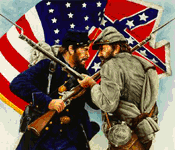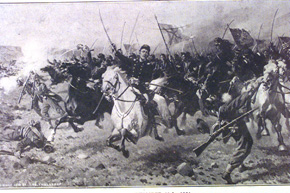 |
Civil War Battles |
|
State War Records |
| AL - AK - AZ - AR - CA - CO - CT - DE - FL - GA - HI - ID - IL - IN - IA - KS - KY - LA - MA - MD - ME - MI - MN - MS - MO - MT - NE - NV - NH - NJ - NM - NY - NC - ND - OH - OK - OR - PA - RI - SC - SD - TN - TX - UT - VT - VA - WA - WV - WI - WY |
The Battle of Winchester (Third)
September 19, 1864 in Frederick County, near Winchester, Virginia (aka Battle of Opequon)
 |
|||||||||||||||||||
|
After Kershaw's division left Winchester to rejoin Lee's army at Petersburg, Lt. Gen. Jubal A. Early renewed his raids on the B&O Railroad at Martinsburg, badly dispersing his four remaining infantry divisions.
By 4:30 A.M. on September 19th, , the Union army encountered its first major hurdle of the day. After crossing Opequon Creek, the Berryville Road passes through the 2-mile narrow Berryville Canyon. General Horatio Wright's VI Corps encountered heavy resistance when it finally exited the canyon.
Additionally, Wright had ordered that the slow-moving wagon trains accompany the soldiers into the canyon. Soon, the narrow canyon became clogged with infantrymen pushing forward, wagon trains laden with supplies, and the wounded filtering back to makeshift hospitals. Gen. William Emory, leading the XIX Corps, incensed by Wright's incompetence, ignored Wright's orders and directed his men to circumvent the wagons. Soldiers of the XIX Corps climbed along the sides of the hills and trampled over the wounded, seriously affecting their morale before even seeing the enemy, and delaying their arrival on the field. Sheridan's attempt to squeeze 20,000 troops through the narrow canyon was a tactical blunder that eliminated any possibility of destroying Early in detail.
The Union advance was delayed long enough for Early to concentrate his forces to meet the main assault.
At 11:40 A.M., cannon on the Union line signaled for the 2nd phase of battle to commence. Col. Jacob Sharpe's and Brig. Gen. Henry Birge's Union brigades of the XIX Corps advanced from the First Woods, located to the southwest of Red Bud Run. Rifle fire by Confederates in the Second Woods, 600 yards away, and pounding artillery from Major James Breathed's six cannon created a deadly crossfire. The Union line began to falter, but a drunken staff officer in Birge's brigade ordered a bayonet charge. The 31st Georgia Infantry ordered a countercharge and struggled in hand-to-hand combat with the Federals in the Second Woods. Unable to withstand the onslaught, the Georgians retreated. Seven of Lt. Col. Carter Braxton's cannon, loaded with shot canister, halted the pursuing Federals. With reinforcements from 2 of Gordon's brigades, the Confederates countercharged and pushed the Federals back into the First Woods. During this fighting, the Federals suffered the loss of every regimental commander and 1,500 casualties. Union reinforcements attempted to charge across the Middle Field, but they never came closer than 200 yards to the Second Woods.
In tandem with the charge of the XIX Corps, the VI Corps advanced and Ramseur's left flank crumbled under the pressure. During the Union advance, however, a gap developed between the two corps. Rodes launched a counterattack into the gap. After shouting, "Charge them, boys! Charge them!" Rodes was killed instantly from an exploding shell. A valiant countercharge by Brig. Gen. Emory Upton broke Rodes's division. Wright would later refer to Upton's charge as "the turning point of the conflict." Both sides were exhausted from the bloody combat and the fighting slackened around 1:00 P.M.
Around 12:30 P.M. in the afternoon, Sheridan ordered Gen. George Crook's Eighth Corps to extend the XIX Corps's line and to attack Early's left flank. Sometime after 3:00 P.M., Col. Isaac Duval's division crossed Red Bud Run and flanked Gordon's division. In the meantime, Col. Joseph Thoburn's division crossed the Middle Field for a frontal attack on Gordon. The 2-pronged assault forced Gordon to retreat to the main body of Confederates, which had formed into an L shape.
By 5:00 P.M., the Confederates had formed a tight interior line position anchored at Star Fort, passing through Fort Collier, bending at Gordon's line to the west of the Second Woods, and ending near the Senseny Road. In a remarkable maneuver, 2 Union cavalry brigades charged against the Confederate infantry around Fort Collier. One Confederate remarked, "I never saw such a sight in my life as the tremendous force, the flying banners, sparkling bayonets, and flashing sabers moving from the north and east upon the left flank and rear of our army." Subsequently, Brigadier General George Custer's men added to the melee, breaking the Confederate right flank. The Confederate line rapidly began to crumble. Luckily for Early, Ramseur and Brig. Gen. Bryan Grimes organized a last stand at Mount Hebron Cemetery in order to allow the Confederates to retreat through the town of Winchester. Additionally, Col. Thomas Munford's cavalry at the Star Fort slowed the advancing Union horsemen.
Early ordered a general retreat. Confederate generals Rodes and Goodwin were killed, Fitzhugh Lee, Terry, Johnson, and Wharton wounded. Union Gens. Russell was killed, McIntosh, Upton, and Chapman wounded. Because of its size, intensity, and result, many historians consider this the most important conflict of the Shenandoah Valley.
After the Third Battle of Winchester, the Confederacy's domination of the Shenandoah Valley would soon come to an end. During the 1864 Valley Campaign, the Confederacy suffered a series of four major defeats over a 30-day period, including the devastating loss at Cedar Creek on October 19. Early was forced to leave the Valley and rejoin Lee near Petersburg. The last campaign to control the Shenandoah Valley had ended and the Union army had gained a major strategic victory. When the last Confederates marched out of Winchester after twelve hours of fighting, they had begun the final Confederate retreat from the Valley. As one veteran poetically wrote, "As the sun was slowly approaching the horizon, the last Confederate army ever in Winchester passed out."
Although the siege at Petersburg still bogged down the Army of the Potomac, Maj. Gen. William T. Sherman's capture of Atlanta on September 2 revived Northern hopes. Union victories in Georgia and in Virginia's Shenandoah Valley breathed new life into the Lincoln administration. Northerners were now determined to see the conflict through and resoundingly voted Lincoln back into office for a second term.
